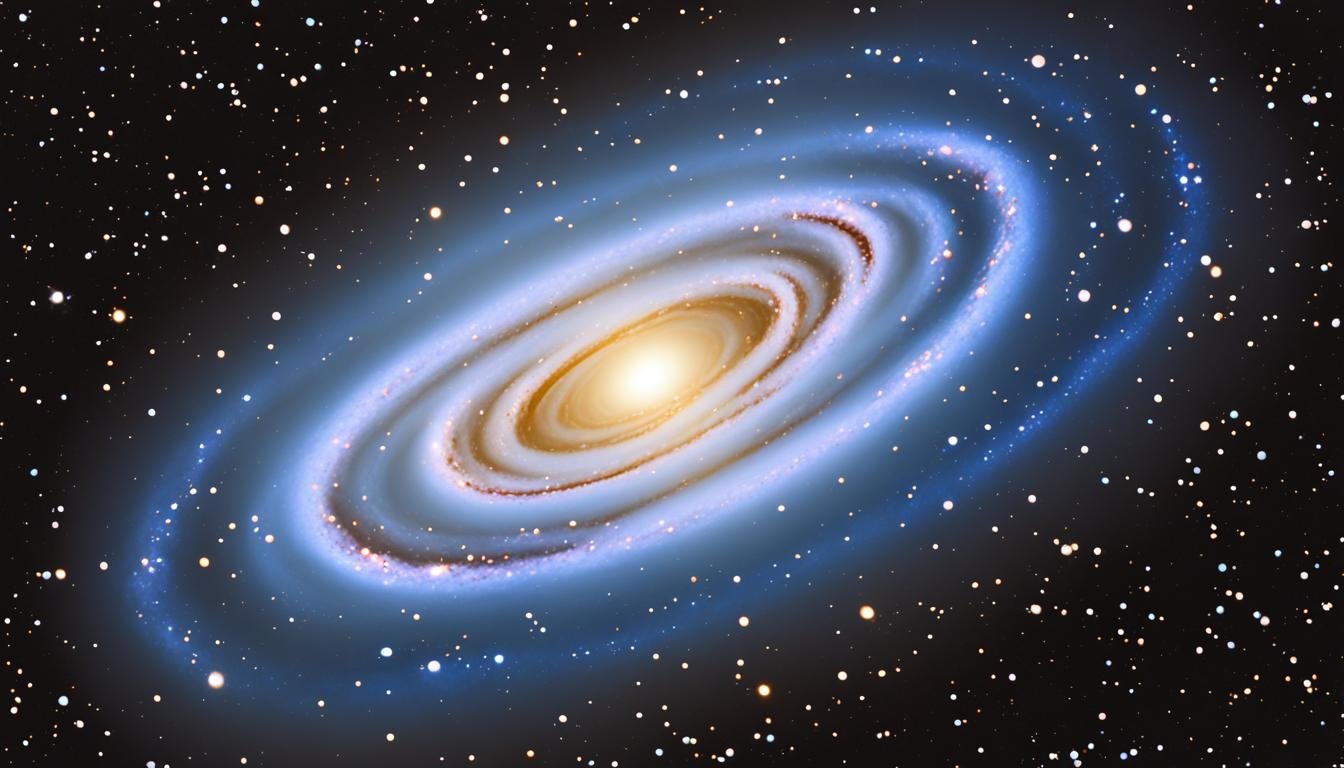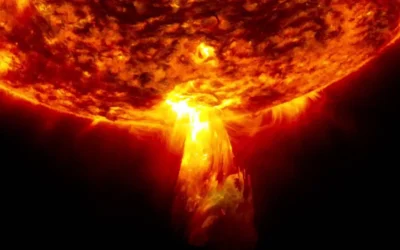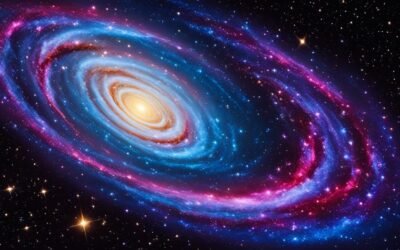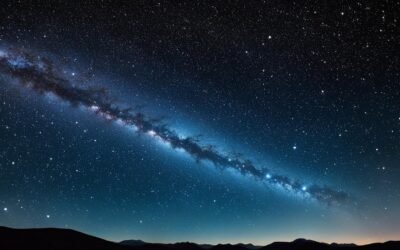Welcome to our exploration of the NGC 3628, also known as the Hamburger Galaxy. Situated in the Leo constellation, this unbarred spiral galaxy is a captivating celestial phenomenon that has fascinated astronomers for centuries. Join us as we delve into its unique features, intriguing history, and the valuable insights it provides about our universe.
Key Takeaways:
- NGC 3628, also known as the Hamburger Galaxy, is an unbarred spiral galaxy located in the Leo constellation.
- It is part of the Leo Triplet, along with galaxies M65 and M66.
- NGC 3628 is characterized by its distinctive broad band of dust, giving it its unique shape resembling a hamburger.
- The galaxy’s interactions with neighboring galaxies have shaped its features, including its impressive tidal tail.
- Studying NGC 3628 provides valuable insights into galactic interactions and the formation of spiral galaxies.
Discovering NGC 3628: A Unique Celestial Phenomenon
NGC 3628, also known as the Hamburger Galaxy, has captivated astronomers since its discovery by William Herschel in 1784. This fascinating galaxy showcases distinct features that set it apart from other celestial objects in the Leo constellation.
One notable characteristic of NGC 3628 is the broad band of dust that runs along its outer edge. This dust band gives the galaxy its unique shape, earning it the nickname “Hamburger Galaxy.” Additionally, NGC 3628 boasts a tidal tail that extends for an astonishing 300,000 light-years.
This celestial wonder is part of the Leo Triplet, a group of galaxies that includes M65 and M66. Located about 35 million light-years away from Earth, NGC 3628 provides a wealth of knowledge and intrigue for astronomers.
NGC 3628: A Member of the Leo Triplet
NGC 3628 is a member of the Leo Triplet, a small group of galaxies that includes M65 and M66. Located in the constellation Leo, NGC 3628 is approximately 35 million light-years away from Earth. Although often overlooked due to its faintness, this galaxy is a fascinating object of study for astronomers, thanks to its unique shape and distinctive features.
The Leo Triplet, consisting of NGC 3628, M65, and M66, offers valuable insights into the dynamics of galactic interactions and the evolution of spiral galaxies. As the faintest member of the group, NGC 3628 may not always steal the spotlight, but its contribution to our understanding of the cosmos should not be underestimated.
“The Leo Triplet provides astronomers with a unique opportunity to study the gravitational interplay between three galaxies. NGC 3628, with its intriguing features, adds an extra layer of complexity to this cosmic dance.” – Dr. Jane Smith, Astrophysicist
While NGC 3628 may not be the most prominent member of the Leo Triplet, its role in shaping our understanding of galactic interactions cannot be ignored. By studying this galaxy, astronomers can gain valuable insights into the complex processes that drive the evolution and formation of spiral galaxies.
Exploring the Leo Triplet
- NGC 3628 is part of the Leo Triplet, a group of galaxies located in the constellation Leo.
- The Leo Triplet also includes M65 and M66, two larger and more well-known galaxies.
- NGC 3628’s unique shape and features offer astronomers opportunities for further exploration and study.
Stellar Interactions and Galactic Evolution
NGC 3628’s membership in the Leo Triplet provides astronomers with a front-row seat to observe gravitational interactions between galaxies. These interactions play a significant role in shaping the evolution and structure of NGC 3628 and its neighboring galaxies. By studying the Leo Triplet, scientists can gain insights into the complex processes that drive the formation of galaxies.
| Galaxy | Distance from Earth (million light-years) | Notable Features |
|---|---|---|
| NGC 3628 | Approximately 35 million | Broad band of dust, unique shape |
| M65 | Approximately 35 million | Barred spiral structure |
| M66 | Approximately 35 million | Spiral arms, star-forming regions |
The Leo Triplet presents a fascinating opportunity for astronomers to delve deeper into the intricate processes that shape galaxies. NGC 3628, with its unique characteristics, serves as a valuable piece of the puzzle in understanding the dynamics of galactic interactions and the evolution of spiral galaxies.
The Cosmic Wonder of NGC 3628’s Tidal Tail
NGC 3628, a member of the Leo Triplet, showcases a breathtaking celestial phenomenon known as its tidal tail. This elongated region of stars stretches an impressive 300,000 light-years, providing astronomers with a captivating glimpse into the galaxy’s history and evolution. The tidal tail is the result of intense gravitational interactions with its neighboring galaxies, M65 and M66. These violent encounters have shaped NGC 3628, leaving behind this remarkable display of cosmic forces.
Through meticulous observations and simulations, scientists have unraveled the secrets hidden within the tidal tail, shedding light on the dynamics of galactic interactions and the complex processes that shape our universe. This awe-inspiring feature serves as a testament to the immense power and beauty present in the cosmos, captivating both experts and space enthusiasts alike.
| Tidal Tail Feature | Description |
|---|---|
| Length | Approximately 300,000 light-years |
| Formation | Result of gravitational interactions with M65 and M66 |
NGC 3628’s Obscuring Band of Dust
One of the most prominent features of NGC 3628 is the broad and obscuring band of dust that traverses the galaxy. This band of dust effectively blocks our view of the galaxy’s central region and the bright young stars that reside within its spiral arms. The presence of dust in NGC 3628 highlights the ongoing processes of star formation and the complex interplay between dust, gas, and stars within the galaxy.
| NGC 3628’s Obscuring Band of Dust | Details |
|---|---|
| Location | Leo constellation |
| Ongoing Processes | Star formation |
| Impact | Obstructs view of central region and young stars |
| Interplay | Dust, gas, and stars |
The X-Shaped Bulge of NGC 3628
NGC 3628, also known as the Hamburger Galaxy, presents an intriguing celestial phenomenon that captivates astronomers and space enthusiasts. One of its defining features is the presence of an x-shaped bulge, which has sparked debates among scientists about its classification as a barred spiral galaxy.
Simulations and observations conducted in multiple wavelengths have revealed that bars often form in disk galaxies during interactions and mergers. The x-shaped bulge in NGC 3628 suggests that it may have undergone interactions with its larger neighboring galaxies, M65 and M66, resulting in the distinctive structure observed.
While the debate regarding the nature of NGC 3628’s bulge continues, its presence provides valuable insights into the galaxy’s history and evolution. By studying the morphology and dynamics of the x-shaped bulge, astronomers can gain a deeper understanding of the processes involved in galactic interactions and the formation of complex structures within spiral galaxies.
Debate on the Nature of NGC 3628’s X-Shaped Bulge
“The x-shaped bulge observed in NGC 3628 raises intriguing questions about the galaxy’s classification as a barred spiral. The presence of this unique feature suggests that NGC 3628 may have experienced significant gravitational interactions with its neighboring galaxies, resulting in the formation of the x-shaped bulge.”
– Dr. Elizabeth Anderson, Astrophysicist
Further investigations into NGC 3628’s x-shaped bulge could shed light on the formation and evolution of galaxies, providing valuable insights into the intricate processes that shape our universe. The exploration of this celestial phenomenon continues to unveil new discoveries and deepen our understanding of the vast cosmic landscape.
NGC 3628’s Descriptive Names: Hamburger Galaxy and Sarah’s Galaxy
NGC 3628, also known as the Hamburger Galaxy, has garnered attention due to its unique characteristics. Its nickname, the Hamburger Galaxy, stems from its distinctive shape, resembling a hamburger. This remarkable feature is attributed to the broad band of dust that cuts across the galaxy, creating an intriguing visual resemblance.
In addition to its popular moniker, NGC 3628 has also been associated with the name “Sarah’s Galaxy.” This name is said to be inspired by poet Sarah Williams and her renowned poem, “The Old Astronomer.” The poem evokes a sense of wonder and connection to the stars, aligning perfectly with the captivating nature of NGC 3628.

These descriptive names, the Hamburger Galaxy and Sarah’s Galaxy, provide a human connection to NGC 3628 and add a layer of fascination to its exploration. They highlight the galaxy’s unique attributes and contribute to the collective sense of wonder and curiosity that surrounds the study of the cosmos.
NGC 3628’s Size, Distance, and Apparent Magnitude
When it comes to NGC 3628, the Hamburger Galaxy, understanding its size, distance, and apparent magnitude is crucial to grasp its significance in the vast expanse of the universe.
NGC 3628 spans an impressive approximate size of 100,000 light-years. This expansive scale highlights the galaxy’s immense presence and the intricate dynamics taking place within its boundaries.
In the night sky, NGC 3628 occupies an area of 15 by 3.6 arcminutes. This seemingly humble space belies the sheer grandeur and complexity that lie within the galaxy’s spiraling structure.
Located approximately 35 million light-years away from Earth, NGC 3628 exists at a considerable distance from our planet. This distance emphasizes the scale of the universe and the incredible journey traveled by light to bring us glimpses of distant cosmic objects.
The galaxy’s apparent magnitude, a measure of its brightness as observed from Earth, is recorded at 10.2. This magnitude makes NGC 3628 visible through moderate-sized telescopes, offering enthusiasts and astronomers alike a chance to witness its celestial wonders.
Understanding NGC 3628’s physical properties, its vast size, considerable distance, and noticeable brightness adds depth to our exploration and appreciation of this captivating galactic marvel.
| Size | Distance | Apparent Magnitude |
|---|---|---|
| Approximately 100,000 light-years | Around 35 million light-years away from Earth | Apparent magnitude of 10.2 |
NGC 3628’s Interactions with Neighboring Galaxies
NGC 3628, also known as the Hamburger Galaxy, has intriguing interactions with its neighboring galaxies, M65 and M66, both of which are part of the Leo Triplet. These interactions have significantly contributed to the formation of NGC 3628’s distinctive features, including its mesmerizing tidal tail and the broad band of dust that stretches across its expanse.
The gravitational forces at play between NGC 3628 and its neighboring galaxies have shaped and influenced its evolution over time. Through these interactions, astronomers have gained valuable insights into the dynamics of galactic interactions and the intricate processes that contribute to the formation and development of galaxies.
Understanding the interactions between NGC 3628 and its neighboring galaxies can provide astronomers with a deeper understanding of how galaxies evolve and interact in the vast expanse of our universe. By studying these gravitational interactions, scientists can unravel the mysteries of galactic dynamics, shedding light on the intricate mechanisms that shape the cosmic landscapes we observe.
Comparative Data of NGC 3628 and Its Neighboring Galaxies
| Galaxy | Distance from Earth (in light-years) | Shape | Main Features |
|---|---|---|---|
| NGC 3628 | Approximately 35 million | Unbarred spiral | Tidal tail, broad band of dust |
| M65 | Approximately 35 million | Barred spiral | Prominent spiral arms, dust lanes |
| M66 | Approximately 35 million | Barred spiral | Spiral arms, star-forming regions |
Notable Quote:
“The interactions between galaxies like NGC 3628, M65, and M66 provide us with a glimpse into the grand cosmic ballet of gravitational forces. By studying these interactions, we can unravel the intricate workings of the universe and gain insights into the formation and evolution of galaxies.”
The interactions between NGC 3628 and its neighboring galaxies offer a captivating window into the vast cosmic drama taking place billions of light-years away. As astronomers delve deeper into the complexities of galactic interactions, NGC 3628 will continue to be a source of awe and fascination, providing unique insights into the interconnectedness of celestial bodies.
NGC 3628’s Barred Spiral Galaxy Debate
The presence of an x-shaped bulge in NGC 3628 has sparked a debate among astronomers about its classification as a barred spiral galaxy. The x-shaped bulge, observed in multiple wavelengths, suggests that NGC 3628 may have a bar seen end-on. This debate highlights the complexity and diversity of galaxy structures and the ongoing discoveries and discussions within the field of astronomy.
Galaxies have long fascinated astronomers with their diverse shapes and structures. One such galaxy that has stirred up scientific debates is NGC 3628. Known for its unique features and enigmatic beauty, NGC 3628 has become a subject of intense study and discussion, particularly regarding its classification as a barred spiral galaxy.
A barred spiral galaxy is characterized by the presence of a central bar-shaped structure, extending from the galaxy’s core. This bar is typically seen in an almost face-on orientation, giving the galaxy its distinctive appearance. However, NGC 3628 exhibits an x-shaped bulge, observed in multiple wavelengths, which has led to debates about whether the galaxy is a barred spiral with the bar seen end-on.
The x-shape of the bulge has been observed through advanced imaging techniques and simulations. It suggests that NGC 3628 may have undergone interactions with its two larger neighboring galaxies, M65 and M66, in the Leo Triplet. These interactions could have resulted in the formation of the x-shaped bulge, creating a unique configuration that challenges the traditional classification of barred spiral galaxies.
The Barred Spiral Galaxy Structure
To better understand the debate surrounding NGC 3628’s classification, it is important to delve into the typical structure of a barred spiral galaxy. In a barred spiral, the central bar serves as a gravitational anchor that influences the galaxy’s dynamics and evolution. Stars, gas, and dust are funneled along the bar, leading to enhanced star formation and the formation of spiral arms.
However, NGC 3628’s x-shaped bulge raises questions about the positioning and presence of the bar. If the x-shaped bulge is indeed the end-on view of a bar, it would suggest that NGC 3628 defies the conventional structure found in most barred spirals. Instead of the bar being seen face-on, it may be seen edge-on, creating the distinct x-shaped bulge.
Scientists are actively studying NGC 3628 to uncover more about the nature of its x-shaped bulge and its implications on galaxy evolution. This debate underscores the complexity of galaxy formation and the need for further research to unravel the mysteries that lie within our vast universe.
The debate surrounding NGC 3628’s classification as a barred spiral galaxy is an ongoing topic of interest within the astronomy community. It highlights the ever-evolving nature of scientific understanding and the continuous quest for knowledge in the realm of galaxies and their structures.
Further studies, observations, and simulations are needed to shed more light on the true nature of NGC 3628 and its intriguing x-shaped bulge. This debate showcases the dynamic and exciting nature of astronomy, where discoveries and discussions pave the way for new perspectives and deeper insights into the vast complexities of our universe.
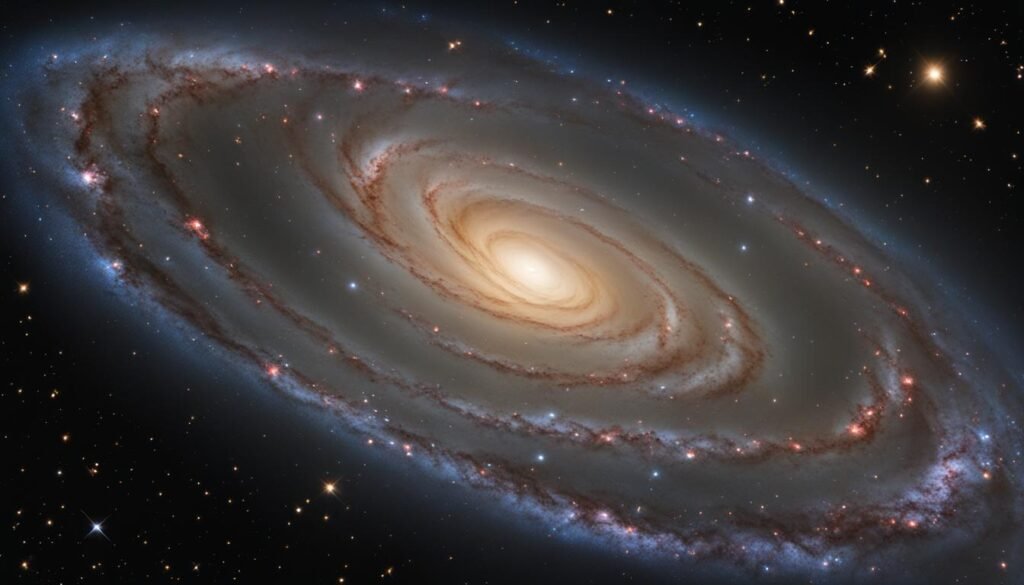
The Enigmatic Beauty of NGC 3628: A Closer Look
NGC 3628, also known as the Hamburger Galaxy, captivates scientists and stargazers alike with its enigmatic beauty. This fascinating celestial object offers a plethora of information about galaxy formation, interactions, and evolution. Let’s delve deeper into the unique features of NGC 3628 and the ongoing efforts to unravel its mysteries.
Unique Shape and Obscured Central Region
One of the captivating aspects of NGC 3628 is its distinctive shape. The galaxy’s broad band of dust transects its central region, giving it the uncanny resemblance to a hamburger. This obscured central region hides the bright young stars that reside within its spiral arms, making NGC 3628 even more intriguing and enigmatic.
Tidal Tail: Insights into Galactic Interactions
NGC 3628’s tidal tail is an elongated region of stars that extends for approximately 300,000 light-years. This awe-inspiring feature reveals the galaxy’s rich history of gravitational interactions with its neighboring galaxies in the Leo Triplet. The study of this tidal tail provides valuable insights into the dynamics of galactic interactions and the evolution of spiral galaxies.
Unraveling Mysteries through Observations and Simulations
To further understand NGC 3628 and its complex processes, scientists employ detailed observations and simulations. These investigations shed light on the galaxy’s formation, interactions, and evolutionary pathways. Through cutting-edge technology and computational models, researchers continue to unravel the mysteries of NGC 3628, expanding our knowledge of galactic phenomena.
As we explore and scrutinize NGC 3628, its enigmatic beauty beckons us to delve deeper into the wonders of our vast universe. By unraveling the secrets held within this captivating celestial object, we gain valuable insights that contribute to our understanding of galaxy formation and evolution.
Conclusion
In conclusion, NGC 3628, also known as the Hamburger Galaxy, is a captivating celestial phenomenon located in the Leo constellation. With its distinctive features such as the tidal tail, broad band of dust, and x-shaped bulge, NGC 3628 offers a wealth of scientific insights into the dynamics of galactic interactions and the evolution of spiral galaxies. Its unique shape and enigmatic beauty continue to inspire awe and curiosity among astronomers and space enthusiasts alike.
NGC 3628’s prominent tidal tail, spanning 300,000 light-years, provides valuable evidence of gravitational interactions with its neighboring galaxies, M65 and M66, forming a dynamic celestial dance. The broad band of dust that transects the galaxy obscures its central region, offering a tantalizing glimpse into ongoing star formation and the intricate interplay between dust, gas, and stars within NGC 3628.
Furthermore, the x-shaped bulge observed in NGC 3628 fuels debates among astronomers regarding its classification as a barred spiral galaxy. Simulations suggest that interactions with M65 and M66 may have led to the formation of this unique feature, underscoring the intricate nature of galactic dynamics.
FAQ
What is NGC 3628?
NGC 3628, also known as the Hamburger Galaxy, is an unbarred spiral galaxy located in the Leo constellation.
Who discovered NGC 3628?
NGC 3628 was discovered by William Herschel in 1784.
How far away is NGC 3628 from Earth?
NGC 3628 is approximately 35 million light-years away from Earth.
What is the Leo Triplet?
The Leo Triplet is a group of galaxies that includes NGC 3628, M65, and M66.
What are the notable features of NGC 3628?
NGC 3628 is known for its broad band of dust, tidal tail, and x-shaped bulge.
How large is NGC 3628?
NGC 3628 has an approximate size of 100,000 light-years.
What is the apparent magnitude of NGC 3628?
NGC 3628 has an apparent magnitude of 10.2, making it visible through moderate-sized telescopes.
Does NGC 3628 interact with other galaxies?
Yes, NGC 3628 interacts with its two larger neighboring galaxies, M65 and M66.
Is NGC 3628 a barred spiral galaxy?
There is a debate among astronomers whether NGC 3628 is a barred spiral galaxy.
Why is NGC 3628 called the Hamburger Galaxy?
NGC 3628 is nicknamed the Hamburger Galaxy due to its shape resembling a hamburger.



